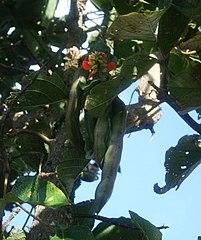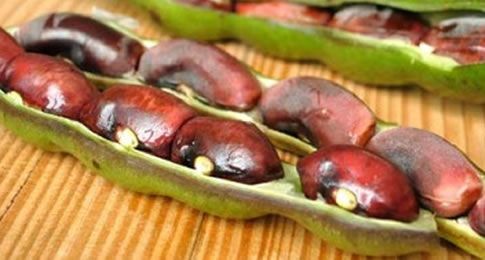Chachafruto
 Common Names: Chachafruto, balú
Common Names: Chachafruto, balú
Scientific Name: Erythrina edulis
Climate: Temperate and temperate-cold. Prefers wetlands
Plant Description: grows between 1,400 to 3,000 m. above sea level. It is a tree with thorny, pubescent branches, reaching up to 14 m in height, and a trunk diameter of 24 cm. The light green leaves are triangular in shape, pointed, smooth, coriaceous, have spines on the petioles and veins. Most of the leaves fall from the tree at the beginning of flowering. The carmin red flowers are 2.8 cm long and 1.2 cm wide and grow in clusters up to 45 cm long. Each cluster has about 200 flowers. But only 12-14 of these flowers become mature legumes - which are fruits of this tree. The flower becomes a long legume in 65 days. The fruits are between 10 to 50 cm long. Each pod has between 8 to 12 seeds on average. The seeds are shaped like a large bean, with a dark red husk. The tree lives up to 40 years and is productive throughout its life.
Native to the Andes.
Cultivation: Full sun or half shade. It grows in loose, black and well aerated soils, but it has some tolerance to temporary water logging. When sown in acidic soils it is necessary to apply lime. Chachafruto can be sown in association with other crops such as coffee and orange. It can be propagated by seeds and cuttings.
By seed: Selected seeds should be in good size, healthy and collected directly from the tree. Planting should be in the same week that their collection. The seed is sown in a 25 cm long plastic bag. Seeding should be slightly under surface when a little bit of the seed is being visible. It should be planted in the position with its back upward and the navel downward . The seed germinates in 11 days. After 60 days it must be taken to the greenhouse and sown in a seedling that is 40 cm deep. It can be taken to the field when it is 35 cm high. A 30x30x30 cm hole is made where fertilizer or chicken manure is put. During the first two years it is important to clean every 3 months.
By cuttings: Cutting the branches should be done in the waning moon phase. Cuttings should be 1 to 1.20 m. long and should be cut from the middle part of the crown. They need to be buried 20 cm. deep.
The tree begins to bear fruit at 27 months of age. The older it is, the more fruit it produces. It is recommended to collect the fruits directly from the tree as those in the ground are attacked by worms and fungi. You have to be careful not to damage the flowers as the next harvests will decrease. Fresh seeds have a high water content, so grains cannot be stored very well. It is better to use them immediately.
The tree requires a lot of water, especially during the first 10 months after planting. Then it resists lack of water but its development will be slow. It is very susceptible to frost and strong winds. The first 5 years it is important to keep the trees free of weeds. They must be pruned periodically, especially during winter to avoid development and growth of the yolk borer larvae. During pruning it is necessary to remove all cut material to protect the plant from pests and diseases.
 Uses: Chachafruto is a multipurpose plant as its leaves, seeds and fruit peel are being used for different purposes. They are eaten boiled or fried, in arepas, meringues, ice creams, juices, custard, sweet jams, preserves. The chachafruto seed (grain) has more protein than beans, lentils or garbanzo beans.2 To use the grains for human consumption, it is necessary to remove the husks and boil or fry them for 45 minutes. They can be used in soups, cakes, salads, and tortillas. After the boiling process they can be dried, ground and used as flour for different purposes.
Uses: Chachafruto is a multipurpose plant as its leaves, seeds and fruit peel are being used for different purposes. They are eaten boiled or fried, in arepas, meringues, ice creams, juices, custard, sweet jams, preserves. The chachafruto seed (grain) has more protein than beans, lentils or garbanzo beans.2 To use the grains for human consumption, it is necessary to remove the husks and boil or fry them for 45 minutes. They can be used in soups, cakes, salads, and tortillas. After the boiling process they can be dried, ground and used as flour for different purposes.
The seed is used to treat cystitis and difficulty urinating. Cooked water from the flowers is used to relieve eye irritation.
Tree contributes nitrogen to the soil. It also provides shade to protect sun-sensitive crops from strong radiation.
The tree is a protector of river banks, streams and springs.
The leaves, pods and seeds are used in feed for cattle, horses, pigs, chickens and rabbits thanks to the high protein content. Due to its nutritional value, the husk is used in cows and goats' feed as well as a fertilizer that improves the soil.
Pests and Diseases: The seedling is attacked by a larva in the terminal bud that augers the stem. Leaf miner - attacks the leaf and leaf fungus appears on leaves during the dry season. Piercing larva - attacks fruits and seeds.
References:
Guía para el cultivo y aprovechamiento del Chachafruto o Balú : Erythrina edulis triana ex micheli by Acero Duarte, Luis Enrique; Bernal Malagón, Henry Yesid; Ruano Cáceres, Laura Victoria. Edition: Segunda edición corregida y aumentada, agosto de 2002
Guía para el cultivo y aprovechamiento del Chachafruto o Balú : Erythrina edulis triana ex micheli by Acero Duarte, Luis Enrique; Bernal Malagón, Henry Yesid; Ruano Cáceres, Laura Victoria. Edition: Segunda edición corregida y aumentada, agosto de 2002
Barrere, N., "A quick guide to useful nitrogen fixing trees from around the world", NFT Highlights', 1994
En español: Chachafruto
